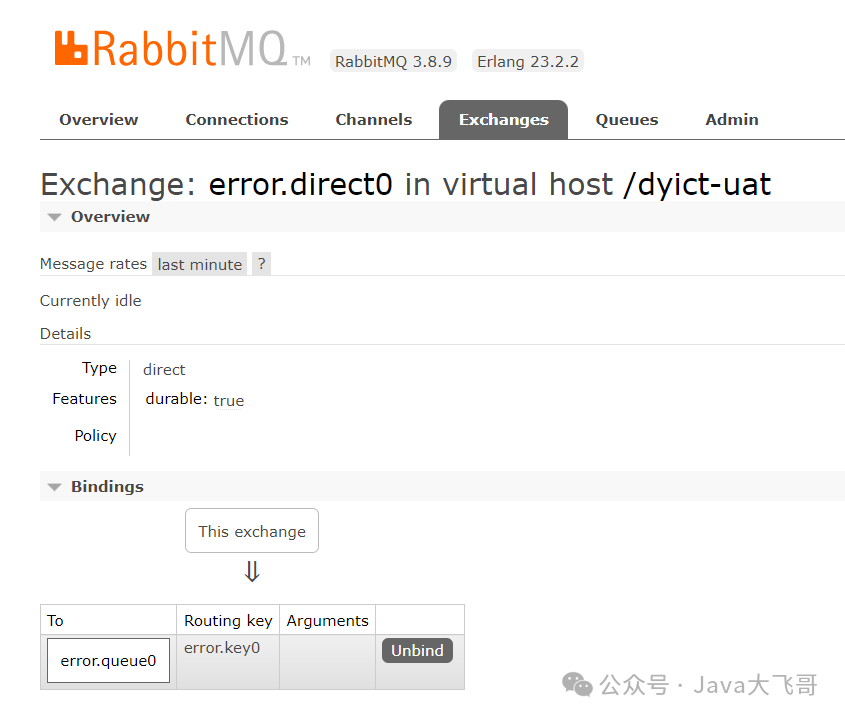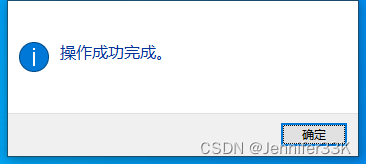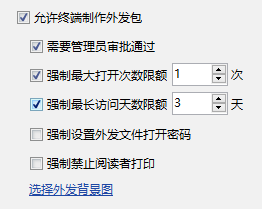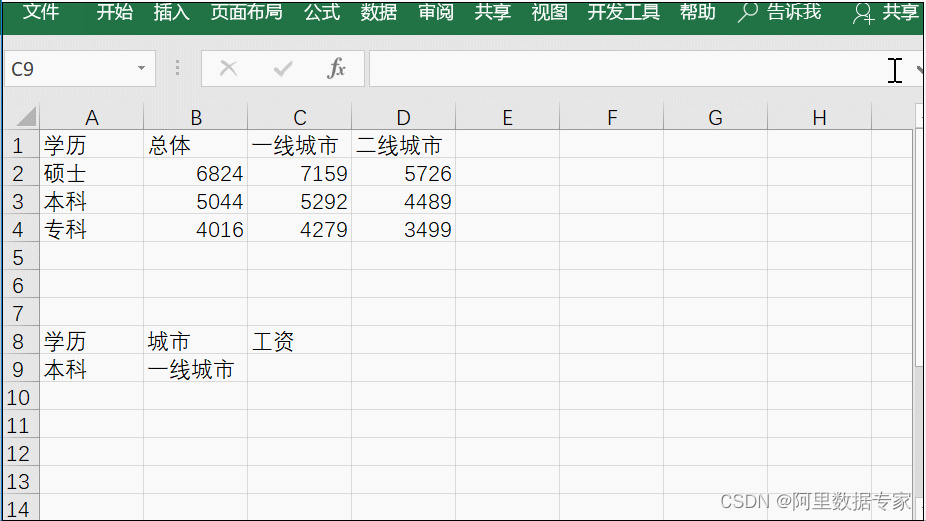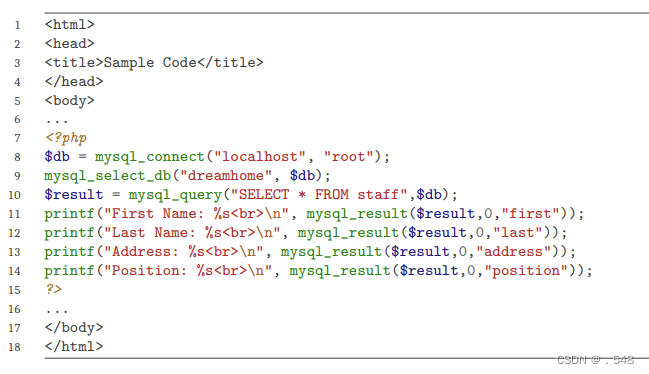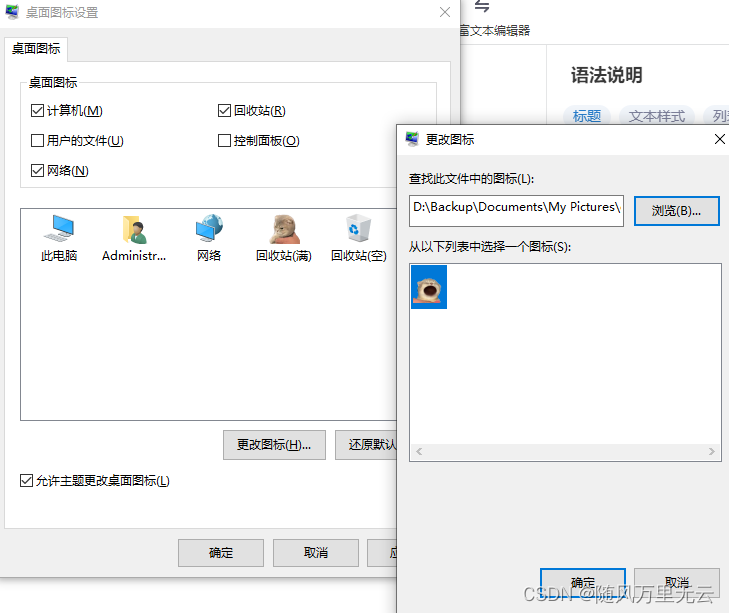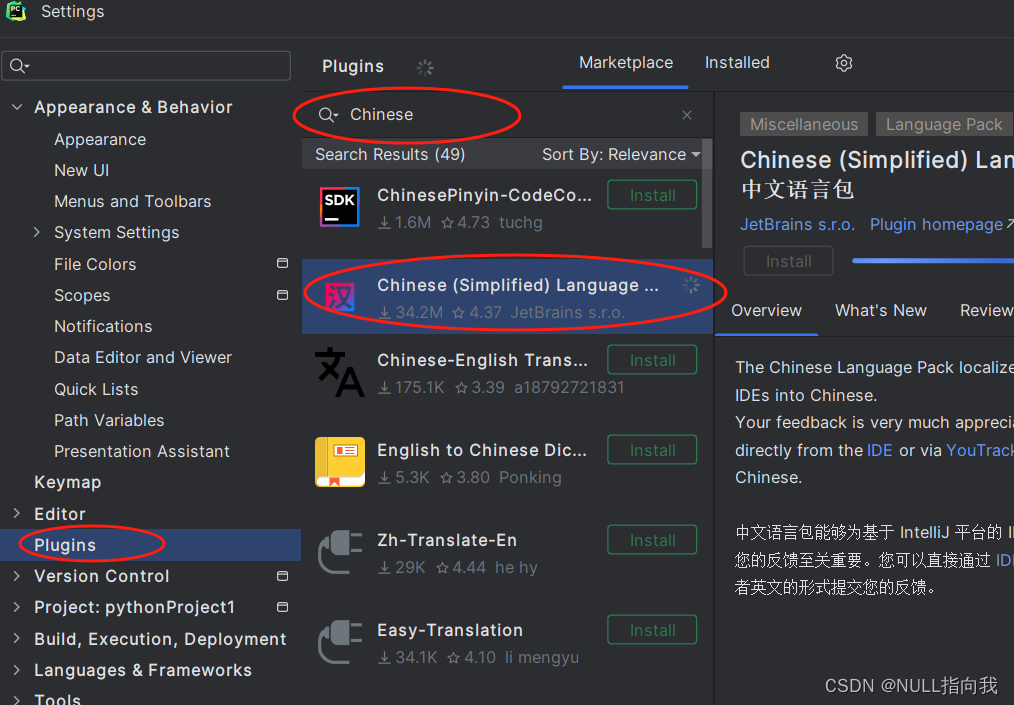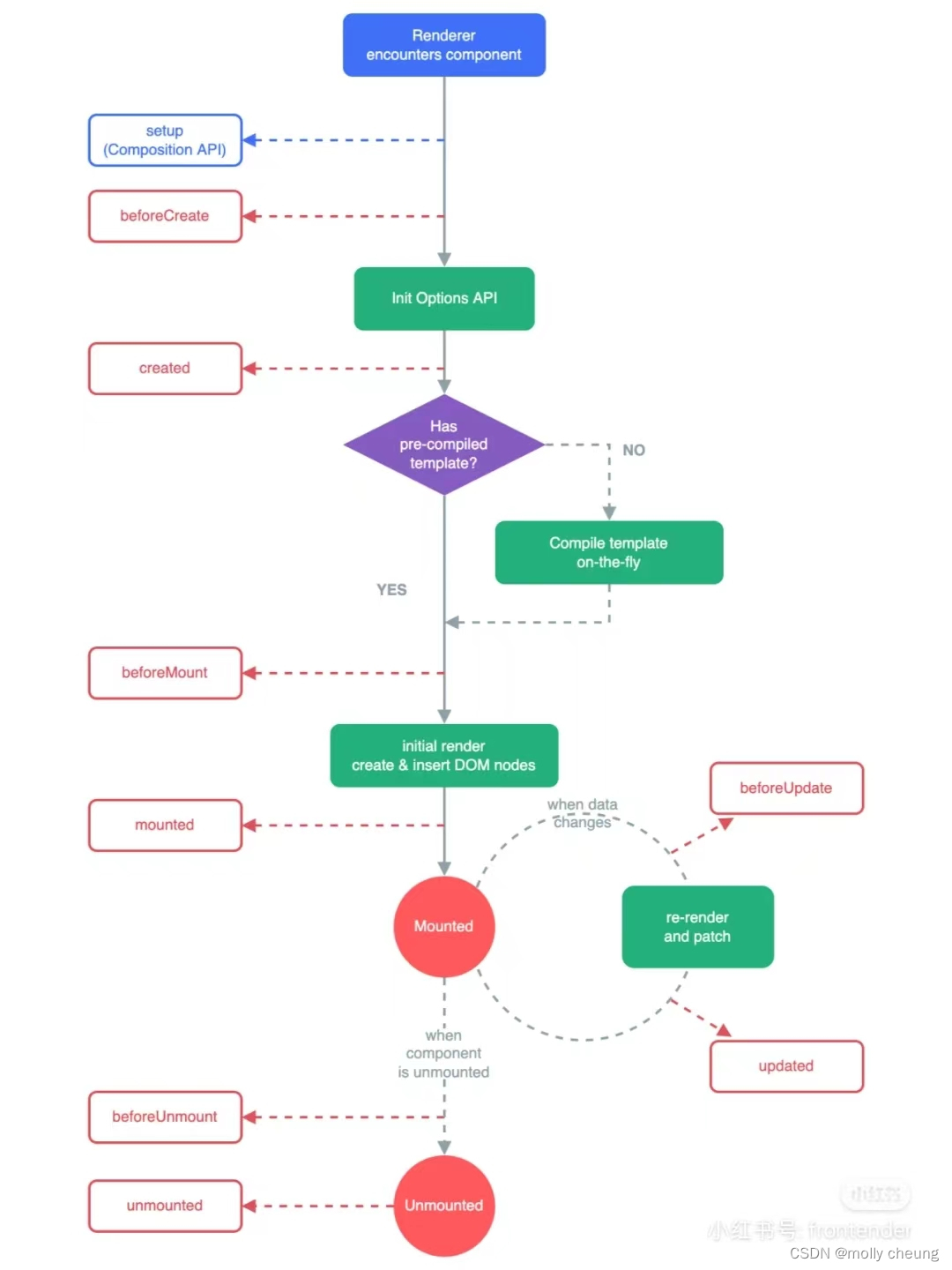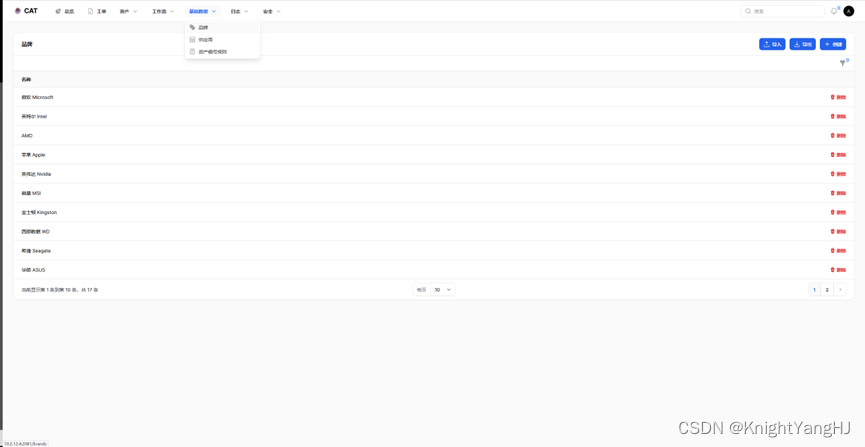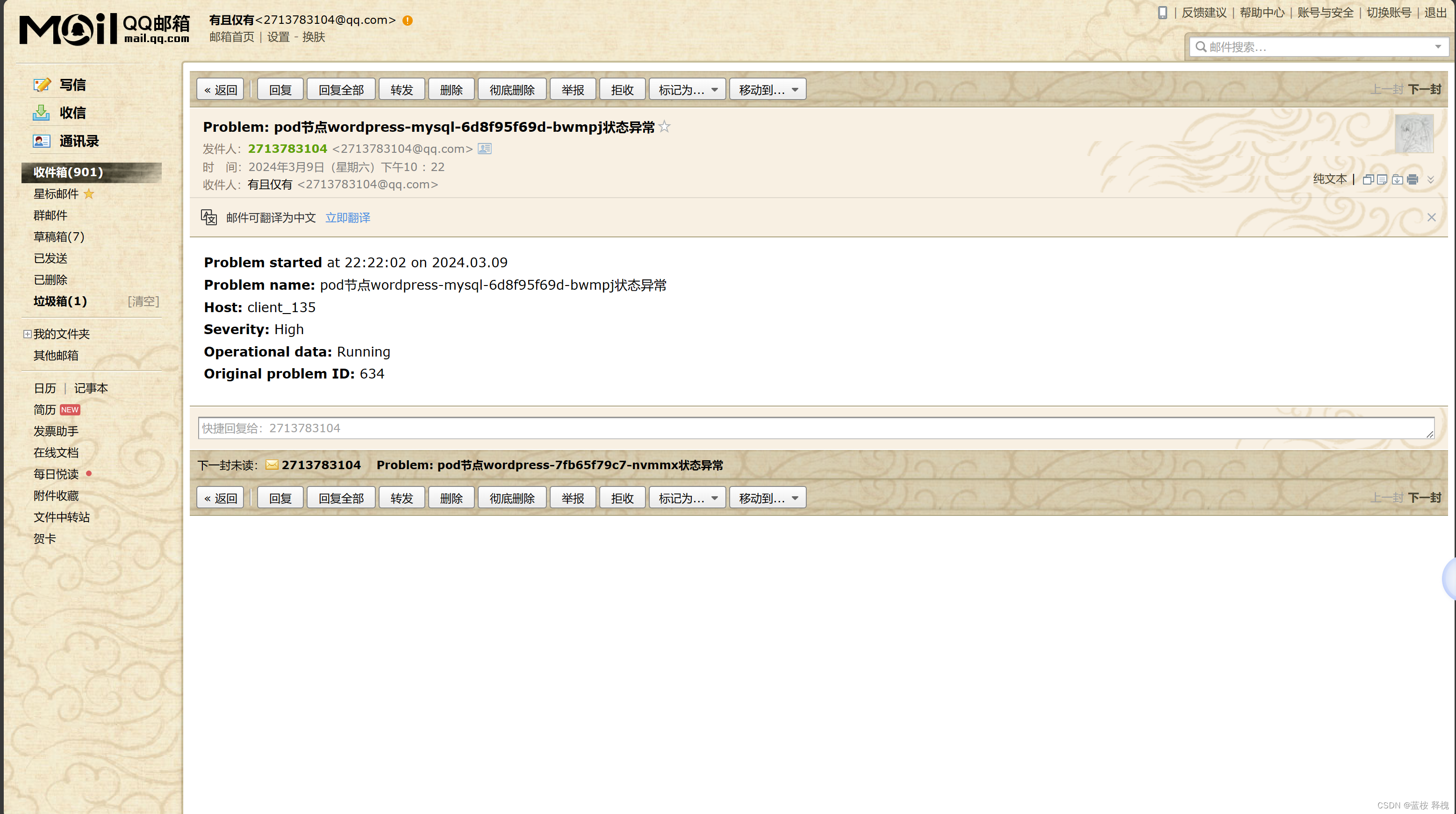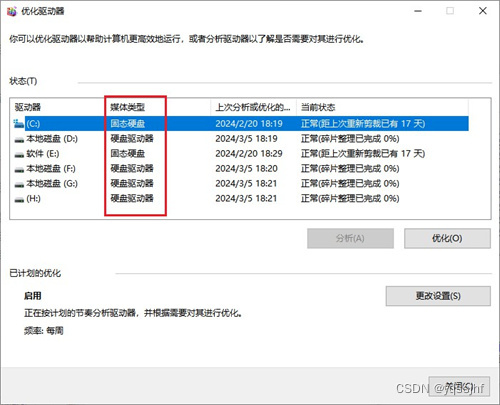rabbitmq-spring-boot-start配置使用手册
文章目录
- 1.yaml配置如下
- 2.引入pom依赖如下
- 2.1 引入项目resources下libs中的jar包依赖如下
- 2.2引入maven私服依赖如下
- 3.启动类配置如下
- 4.项目中测试发送消息如下
- 5.项目中消费消息代码示例
- 6.mq管理后台交换机队列创建及路由绑定关系如下
1.yaml配置如下
rps中的每一个都可以按照Sping官方的RabbitAutoConfiguration自动装配的RabbitProperties的样式来配置,做到了实现配置多个rabbitMq服务器配置和一个rabbitMq服务器下可以配置多个不同类型的交换机和队列进行绑定,还实现了普通队列发送消息、
一:延迟插件实现延迟队列
交换机类型必须CustomExchange
二:TTL + 死信队列/延迟交换机实现延迟队列
三: 延迟交换机 + 消息设置setHeader(“x-delay”, xxx)
以下配置了两个不同的rabbitMq服务器,每一个rabbitMq服务器对应多个队列,还配置了两个相同的rabbitMq服务器,只不过两个相同的rabbitMq服务器有不同的交换机,都是一个rabbitMq服务器可以对应相同的一套配置,代码功能服用性强,也方便快捷
## 配置需要保证唯一不重复(eqps中的每一的index唯一,一般配置成递增的,队列交换机绑定关系的bean注入都是根据rps的List下标+eqps中index下标注入保证了唯一性)
zlf:
rabbit:
rps:
## 如果virtual-host不同,在配置一个即可,addresses不同也是可以在配置,eqps的下标以之对应上即可
- rabbitmq:
virtual-host: /dyict-uat
addresses: 192.168.40.61
port: 5672
username: "admin"
password: "admin"
- rabbitmq:
virtual-host: /test
addresses: 192.168.40.60
port: 5672
username: "admin"
password: "admin"
- rabbitmq:
virtual-host: /test2
addresses: 192.168.40.60
port: 5672
username: "admin"
password: "admin"
eqps:
## 下标递增且唯一
- index: 0
eqs:
- function-type: Delay
delay-type: 1
exchange-type: custom
exchange-name: zlf.delay.test1
queue-name: delay.test1
routing-key: delay.test1.key
exchange-args:
x-delayed-type: direct
queue-args: {}
- function-type: Normal
delay-type: 0
exchange-type: direct
exchange-name: zlf.normal.test1
queue-name: normal.test1
routing-key: normal.test1.key
exchange-args: {}
queue-args: {}
- function-type: Delay
delay-type: 2
exchange-type: direct
exchange-name: zlf.delay.test2
queue-name: delay.test2
## 不用监听正常的队列,直接根据同一个路由键去路由,然后监听死信队列
routing-key: zlf.delay-test2-key
dlx-exchange-name: zlf.dlx-test1
dlx-exchange-type: direct
dlx-queue-name: dlx-test1
dlx-key: zlf.dlx-test1-key
exchange-args: {}
queue-args:
x-dead-letter-exchange: zlf.dlx-test1
x-dead-letter-routing-key: zlf.dlx-test1-key
## 单位毫秒 30s
x-message-ttl: 30000
- function-type: Delay
delay-type: 3
exchange-type: direct
exchange-name: zlf.delay.test3
queue-name: delay.test3
routing-key: zlf.delay-test3-key
exchange-args: {}
queue-args: {}
- index: 1
eqs:
- function-type: Delay
delay-type: 1
exchange-type: custom
exchange-name: zlf.delay.test1
queue-name: delay.test1
routing-key: delay.test1.key
exchange-args:
x-delayed-type: direct
queue-args: {}
- function-type: Normal
delay-type: 0
exchange-type: direct
exchange-name: zlf.normal.test1
queue-name: normal.test1
routing-key: normal.test1.key
exchange-args: {}
queue-args: {}
- function-type: Delay
delay-type: 2
exchange-type: direct
exchange-name: zlf.delay.test2
queue-name: delay.test2
## 不用监听正常的队列,直接根据同一个路由键去路由,然后监听死信队列
routing-key: zlf.delay-test2-key
dlx-exchange-name: zlf.dlx-test1
dlx-exchange-type: direct
dlx-queue-name: dlx-test1
dlx-key: zlf.dlx-test1-key
exchange-args: {}
queue-args:
x-dead-letter-exchange: zlf.dlx-test1
x-dead-letter-routing-key: zlf.dlx-test1-key
## 单位毫秒 30s
x-message-ttl: 30000
- function-type: Delay
delay-type: 3
exchange-type: direct
exchange-name: zlf.delay.test3
queue-name: delay.test3
routing-key: zlf.delay-test3-key
exchange-args: {}
queue-args: {}
- index: 2
eqs:
- function-type: Delay
delay-type: 1
exchange-type: custom
exchange-name: zlf.delay.test1
queue-name: delay.test1
routing-key: delay.test1.key
exchange-args:
x-delayed-type: direct
queue-args: {}
- function-type: Normal
delay-type: 0
exchange-type: direct
exchange-name: zlf.normal.test1
queue-name: normal.test1
routing-key: normal.test1.key
exchange-args: {}
queue-args: {}
- function-type: Delay
delay-type: 2
exchange-type: direct
exchange-name: zlf.delay.test2
queue-name: delay.test2
## 不用监听正常的队列,直接根据同一个路由键去路由,然后监听死信队列
routing-key: zlf.delay-test2-key
dlx-exchange-name: zlf.dlx-test1
dlx-exchange-type: direct
dlx-queue-name: dlx-test1
dlx-key: zlf.dlx-test1-key
exchange-args: {}
queue-args:
x-dead-letter-exchange: zlf.dlx-test1
x-dead-letter-routing-key: zlf.dlx-test1-key
## 单位毫秒 30s
x-message-ttl: 30000
- function-type: Delay
delay-type: 3
exchange-type: direct
exchange-name: zlf.delay.test3
queue-name: delay.test3
routing-key: zlf.delay-test3-key
exchange-args: {}
queue-args: {}
2.引入pom依赖如下
2.1 引入项目resources下libs中的jar包依赖如下
右键点击rabbitmq-spring-boot-start-1.0-SNAPSHOT.jar将该jar包手动导入(add as Library),复制该jar包到resources下libs,若果maven自动导入就不用右键手动导入
<dependency>
<groupId>org.zlf</groupId>
<artifactId>rabbitmq-spring-boot-start</artifactId>
<version>1.0-SNAPSHOT</version>
<scope>system</scope>
<systemPath>${pom.basedir}/src/main/resources/libs/rabbitmq-spring-boot-start-1.0-SNAPSHOT.jar</systemPath>
</dependency>
2.2引入maven私服依赖如下
<dependency>
<groupId>org.zlf</groupId>
<artifactId>rabbitmq-spring-boot-start</artifactId>
<version>1.0-SNAPSHOT</version>
</dependency>
3.启动类配置如下
@EnableZlfRabbitMq
@Import(value = {RabbitService.class, ZlfMqSpringUtils.class})
@SpringBootApplication(exclude = {
RabbitAutoConfiguration.class})
4.项目中测试发送消息如下
Controller测试可以根据rps的下标 + eqps的index下标来复制多个Controlle类,只需要调用api设置这两个下标对应解析即可发送
rabbitService.sendMsg6(0, 0, msg);
rabbitService.sendMsg6(1, 0, msg);
rabbitService.sendMsg6(2, 0, msg);
,,,,,,,,,,
上面配置了三个下标组合就有以下几种:
0 0 / 01 /11
1 0 / 11 /12
2 0 / 21 / 22
可以复制Controller1、Controller2、Controller3,,,,,,,调用时候只需要指定下标组合即可发送消息
package xxxx.controller;
import com.dy.corporate.member.utils.SpringUtils;
import com.zlf.constants.ZlfMqRegistrarBeanNamePrefix;
import com.zlf.service.RabbitService;
import lombok.extern.slf4j.Slf4j;
import org.springframework.amqp.rabbit.core.RabbitTemplate;
import org.springframework.beans.factory.annotation.Autowired;
import org.springframework.web.bind.annotation.GetMapping;
import org.springframework.web.bind.annotation.RequestMapping;
import org.springframework.web.bind.annotation.RequestParam;
import org.springframework.web.bind.annotation.RestController;
@Slf4j
@RestController
@RequestMapping("rabbit")
public class RabbitMqTestController {
@Autowired
private RabbitService rabbitService;
@GetMapping("/sendDelayMsg")
public String sendDelayMsg(@RequestParam(value = "msg") String msg) {
log.info("sendDelayMsg.msg:{}", msg);
RabbitTemplate rabbitTemplate = (RabbitTemplate) SpringUtils.getBean(ZlfMqRegistrarBeanNamePrefix.rabbitTemplatePrefix + 0);
rabbitService.sendDelayed(rabbitTemplate, "zlf.delay.test1", "delay.test1.key", msg, 10);
return "ok";
}
@GetMapping("/sendDelayMsg2")
public String sendDelayMsg2(@RequestParam(value = "msg") String msg) {
log.info("sendDelayMsg2.msg:{}", msg);
rabbitService.sendMsg6(0, 0, msg);
return "ok";
}
@GetMapping("/sendNormalMsg")
public String sendNormalMsg(@RequestParam(value = "msg") String msg) {
log.info("sendNormalMsg.msg:{}", msg);
RabbitTemplate rabbitTemplate = (RabbitTemplate) SpringUtils.getBean(ZlfMqRegistrarBeanNamePrefix.rabbitTemplatePrefix + 0);
rabbitService.sendMsg(rabbitTemplate, "zlf.delay.test1", "delay.test1.key", msg);
return "ok";
}
@GetMapping("/sendNormalMsg2")
public String sendNormalMsg2(@RequestParam(value = "msg") String msg) {
log.info("sendNormalMsg2.msg:{}", msg);
rabbitService.sendMsg6(0, 1, msg);
return "ok";
}
@GetMapping("/sendDelayDlxMsg")
public String sendDelayDlxMsg(@RequestParam(value = "msg") String msg) {
log.info("sendDelayDlxMsg.msg:{}", msg);
RabbitTemplate rabbitTemplate = (RabbitTemplate) SpringUtils.getBean(ZlfMqRegistrarBeanNamePrefix.rabbitTemplatePrefix + 0);
//正常发延迟交换机和延迟队列的路由键
rabbitService.sendDelayed(rabbitTemplate, "zlf.delay.test2", "zlf.delay-test2-key", msg, 10);
return "ok";
}
@GetMapping("/sendDelayDlxMsg2")
public String sendDelayDlxMsg2(@RequestParam(value = "msg") String msg) {
log.info("sendDelayDlxMsg2.msg:{}", msg);
//正常发延迟交换机和延迟队列的路由键
rabbitService.sendDelayed6(0, 2, msg,10);
return "ok";
}
@GetMapping("/sendDelayMsg3")
public String sendDelayMsg3(@RequestParam(value = "msg") String msg) {
log.info("sendDelayMsg3.msg:{}", msg);
rabbitService.sendDelayed6(0, 3, msg, 10);
return "ok";
}
}
项目utils下放入SpringUtils类:
package xxx.utils;
import org.slf4j.Logger;
import org.slf4j.LoggerFactory;
import org.springframework.beans.BeansException;
import org.springframework.context.ApplicationContext;
import org.springframework.context.ApplicationContextAware;
import org.springframework.stereotype.Component;
/**
* @author zlf
* @description spring上下文工具类
* @date 2024/03/11
**/
@Component
public class SpringUtils implements ApplicationContextAware {
private static final Logger logger = LoggerFactory.getLogger(SpringUtils.class);
private static ApplicationContext applicationContext;
@Override
public void setApplicationContext(ApplicationContext applicationContext) throws BeansException {
logger.info("应用程序上下文 : [{}]", "开始初始化");
SpringUtils.applicationContext = applicationContext;
logger.info("应用程序上下文 : [{}]", "初始化完成");
}
/**
* 获取applicationContext
*发给
* @return
*/
public static ApplicationContext getApplicationContext() {
return applicationContext;
}
/**
* 通过name获取 Bean.
*
* @param name
* @return
*/
public static Object getBean(String name) {
return getApplicationContext().getBean(name);
}
/**
* 通过class获取Bean.
*
* @param clazz
* @param <T>
* @return
*/
public static <T> T getBean(Class<T> clazz) {
return getApplicationContext().getBean(clazz);
}
/**
* 通过name,以及Clazz返回指定的Bean
*
* @param name
* @param clazz
* @param <T>
* @return
*/
public static <T> T getBean(String name, Class<T> clazz) {
return getApplicationContext().getBean(name, clazz);
}
}
以上测试用例MqConsumer都是可以正常消费到对应队列中的消息的
5.项目中消费消息代码示例
消费者中只需要指定对应的消费监听工厂即可,监听工厂配置如下:
ZlfMqRegistrarBeanNamePrefix.simpleRabbitListenerContainerFactory + rps的下标
可以复制多个MqConsumer1,MqConsumer2,,,,,,,,,
然后指定对应的监听工厂配置下标即可,经过测试上面三个配置发送4中发送消息,监听消费都是正常的
package xxx.listener;
import com.rabbitmq.client.Channel;
import com.zlf.constants.ZlfMqRegistrarBeanNamePrefix;
import lombok.extern.slf4j.Slf4j;
import org.springframework.amqp.core.ExchangeTypes;
import org.springframework.amqp.core.Message;
import org.springframework.amqp.rabbit.annotation.Exchange;
import org.springframework.amqp.rabbit.annotation.Queue;
import org.springframework.amqp.rabbit.annotation.QueueBinding;
import org.springframework.amqp.rabbit.annotation.RabbitHandler;
import org.springframework.amqp.rabbit.annotation.RabbitListener;
import org.springframework.stereotype.Component;
import java.io.IOException;
/**
* 手动ack业务demo
* long deliveryTag = message.getMessageProperties().getDeliveryTag();
* try {
* int a = 1/0;
* User user = JSONObject.parseObject(userStr,User.class);
* log.info(user.toString());
* //手动ack 第二个参数为false是表示仅仅确认当前消息 true表示确认之前所有的消息
* channel.basicAck(deliveryTag,false);
* } catch (Exception e) {
* //手动nack 告诉rabbitmq该消息消费失败 第三个参数:如果被拒绝的消息应该被重新请求,而不是被丢弃或变成死信,则为true
* try {
* channel.basicNack(deliveryTag,false,false);
* } catch (IOException ex) {
* throw new RuntimeException("消息处理失败");
* }
* }
* //channel.basicNack(); 不ack
* //channel.basicReject(); 拒绝
*/
@Slf4j
@Component
public class MqConsumer {
/**
* 延迟插件实现延迟队列监听队列消息
*
* @param message
* @param channel
* @throws IOException
*/
@RabbitHandler
@RabbitListener(queues = "delay.test1", containerFactory = ZlfMqRegistrarBeanNamePrefix.simpleRabbitListenerContainerFactory + 0)
public void mqConsumer1(Message message, Channel channel) throws IOException {
String msg = new String(message.getBody(), "UTF-8");
try {
log.info("mqConsumer1=====>msg:{}", msg);
} catch (Exception e) {
log.error("mqConsumer1消费异常:{}", e.getMessage());
} finally {
channel.basicAck(message.getMessageProperties().getDeliveryTag(), true);
}
//channel.basicNack(); 不ack
//channel.basicReject(); 拒绝
}
/**
* 普通队列监听队列消息
*
* @param message
* @param channel
* @throws IOException
*/
@RabbitHandler
@RabbitListener(queues = "normal.test1", containerFactory = ZlfMqRegistrarBeanNamePrefix.simpleRabbitListenerContainerFactory + 0)
public void mqConsumer2(Message message, Channel channel) throws IOException {
String msg = new String(message.getBody(), "UTF-8");
try {
log.info("mqConsumer2=====>msg:{}", msg);
} catch (Exception e) {
log.error("mqConsumer2消费异常:{}", e.getMessage());
} finally {
channel.basicAck(message.getMessageProperties().getDeliveryTag(), true);
}
}
/**
* TTL + 死信队列实现延迟队列监听延迟队列消息(此处省略)
* 绑定的那个延迟队列,消息如果正常消费,则不会将消息投递到死信队列上,
* 只有消息变成死信才会被投递到死信队列上
*/
/**
* TTL + 死信队列实现延迟队列监听死信队列消息
* 成为死信的条件
* * 1.队列消息长度到达限制。
* * 2.消费者拒接消费消息,basicNack/basicReject,并且不把消息重新放入原目标队列,requeue=false。
* * 3.原队列存在消息过期设置,消息到达超时时间未被消费。
*
* @param message
* @param channel
* @throws IOException
*/
@RabbitHandler
@RabbitListener(
//监听连接工程指定
containerFactory = ZlfMqRegistrarBeanNamePrefix.simpleRabbitListenerContainerFactory + 0,
bindings = @QueueBinding(
//延迟交换机
exchange = @Exchange(
value = "zlf.delay.test2",
//持久化参数设置
durable = "true",
//交换机类型指定
type = ExchangeTypes.DIRECT),
//延迟交换机路由延迟队列的key
key = "zlf.delay-test2-key",
//死信队列
value = @Queue(
value = "dlx-test1",
//持久化参数设置
durable = "true"
//, //autoDelete = "false",
)
//ignoreDeclarationExceptions = "true"
)
//,
//concurrency = "1", // 指定监听该队列的消费者个数
//ackMode = "MANUAL"// 手动ack
)
public void mqConsumer4(Message message, Channel channel) throws IOException {
String msg = new String(message.getBody(), "UTF-8");
try {
log.info("mqConsumer4=====>msg:{}", msg);
} catch (Exception e) {
log.error("mqConsumer4:{}", e.getMessage());
} finally {
channel.basicAck(message.getMessageProperties().getDeliveryTag(), true);
}
}
/**
* 延迟交换机 + 消息设置setHeader("x-delay", xxx)
*
* @param message
* @param channel
* @throws IOException
*/
@RabbitHandler
@RabbitListener(queues = "delay.test3", containerFactory = ZlfMqRegistrarBeanNamePrefix.simpleRabbitListenerContainerFactory + 0)
public void mqConsumer5(Message message, Channel channel) throws IOException {
String msg = new String(message.getBody(), "UTF-8");
try {
log.info("mqConsumer5=====>msg:{}", msg);
} catch (Exception e) {
log.error("mqConsumer5消费异常:{}", e.getMessage());
} finally {
channel.basicAck(message.getMessageProperties().getDeliveryTag(), true);
}
//channel.basicNack(); 不ack
//channel.basicReject(); 拒绝
}
}
6.mq管理后台交换机队列创建及路由绑定关系如下
以下交换机和队列定义的时候都是持久化的,上面三个配置示都在rabbitMq的管理后台生成了相同的队列、交换机和绑定关系(唯一不一样的是错误对了是根据rps的List的下标来的,保证唯一),以下截图只展示一个即rps[0]的交换机、队列和绑定关系的创建,其它两个都是一样的(唯一不同就是错误队列交换机是后缀角标是递增的)。
zlf.delay.test1交换机(延迟插件)
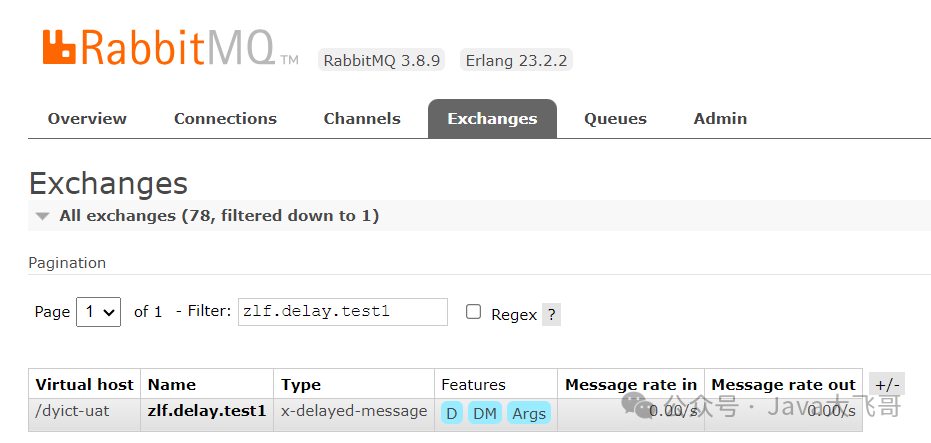
zlf.delay.test1交换和delay.test1队列的绑定关系:
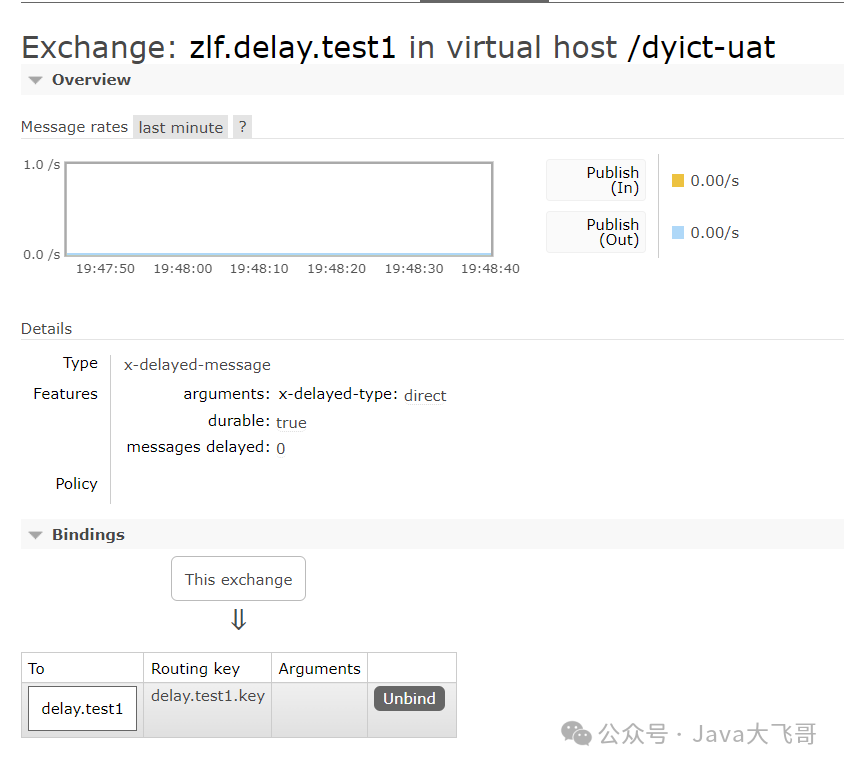
zlf.normal.test1交换机(普通交换机)
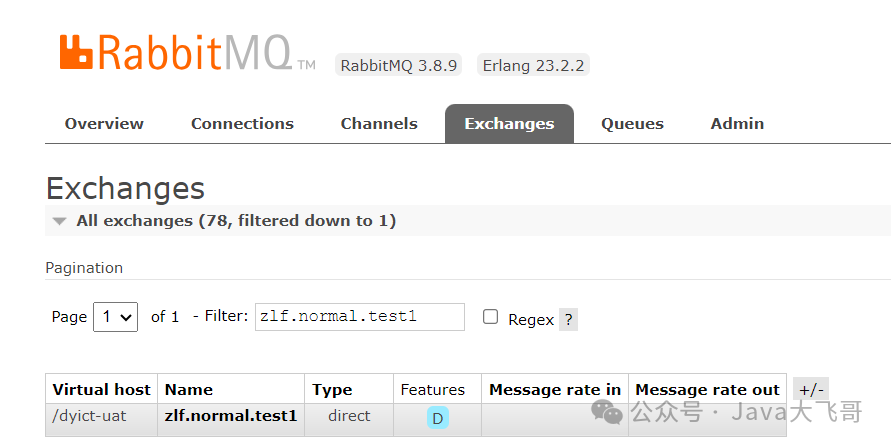
zlf.normal.test1交换机和normal.test1的绑定关系:

zlf.delay.test2交换机:(ttl + 死信队列)
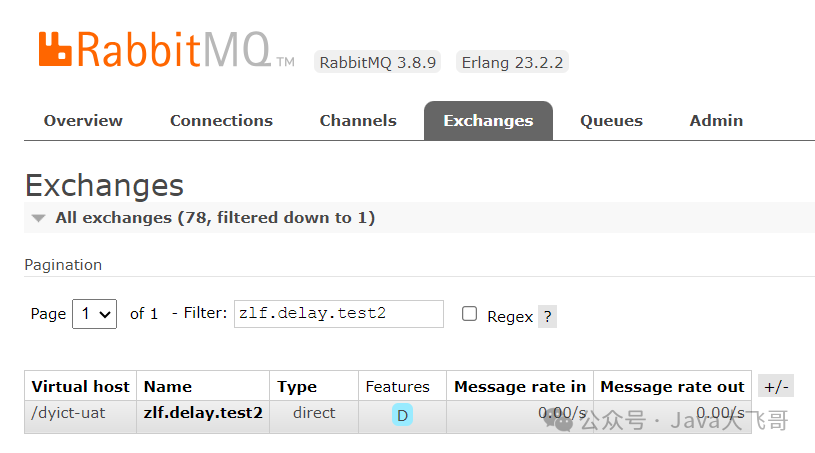
zlf.delay.test2交换机和delay.test2绑定关系:
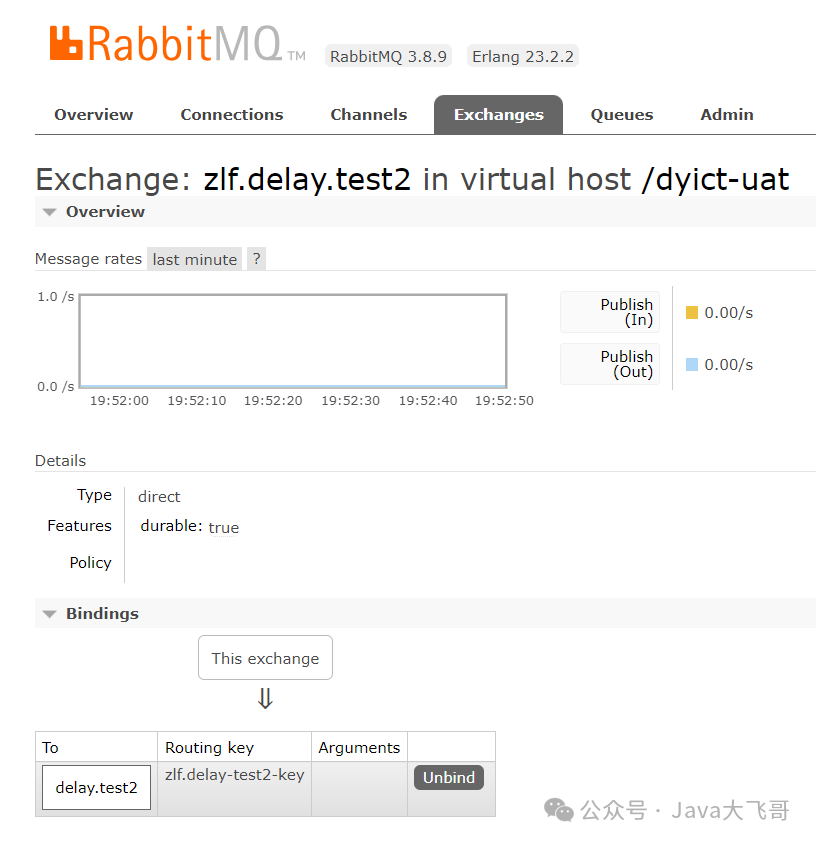
zlf.dlx-test1交换机:(死信交换机)
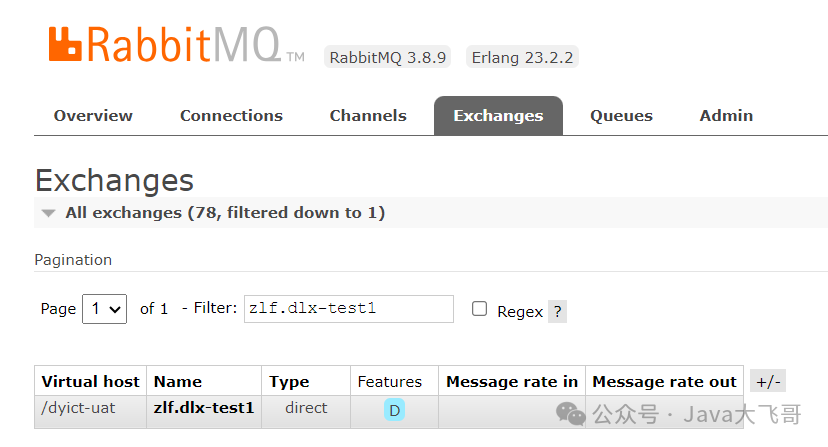
zlf.dlx-test1死信交换机和dlx-test1绑定关系:
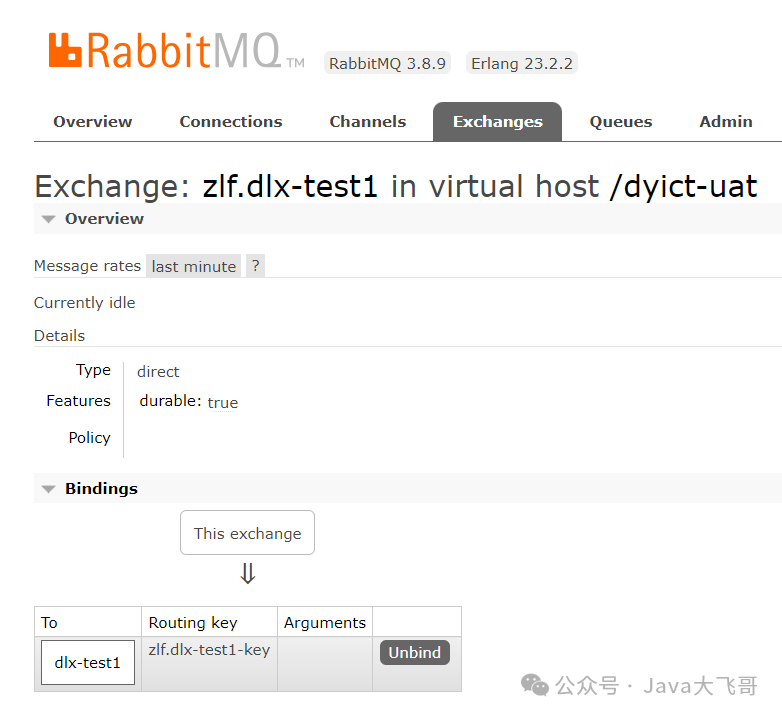
zlf.delay.test3交换机:
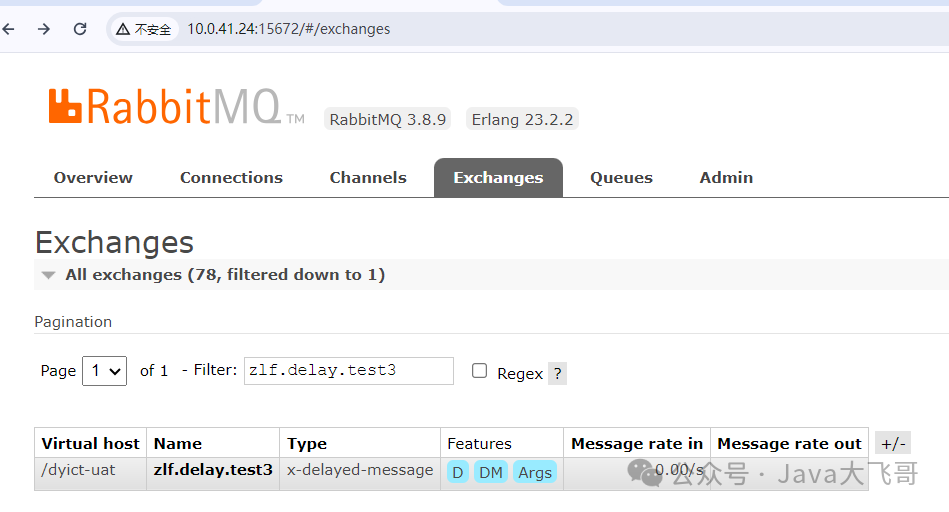
zlf.delay.test3交换机delay.test3的绑定关系:
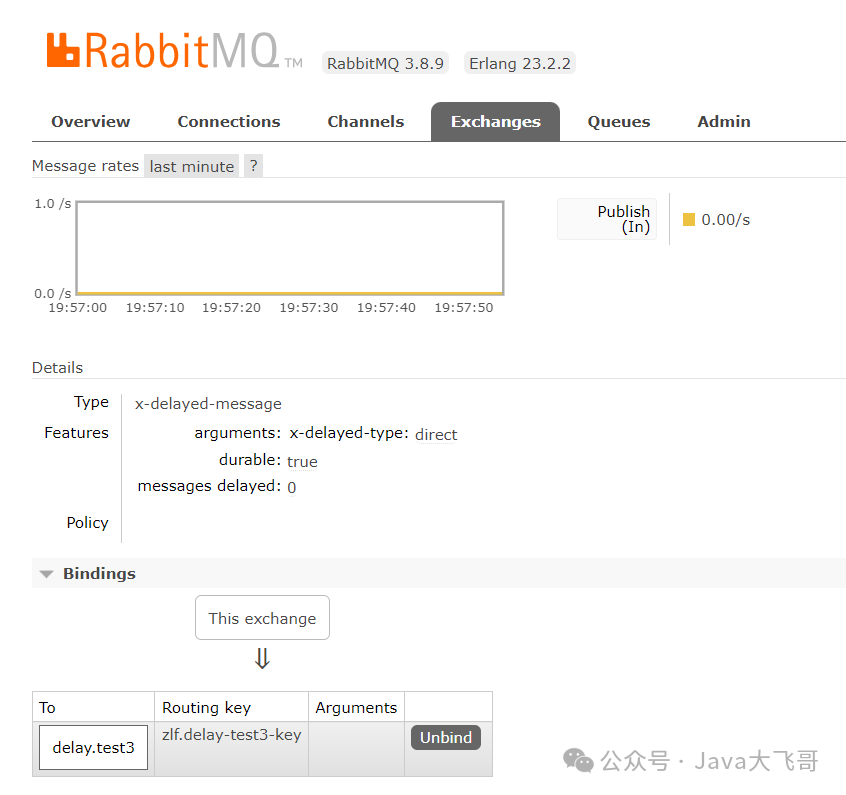
error交换机
error.direct + 一个下标,类型、路由键是固定
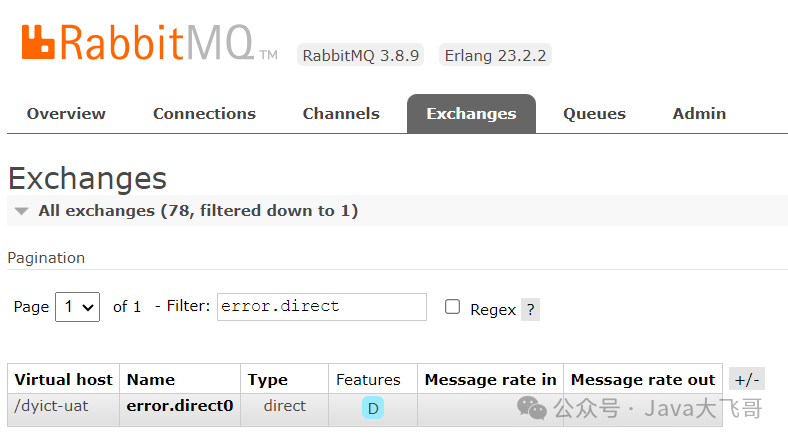
error.direct + 一个下标 和 error.queue+ 一个下标 的绑定关系:
